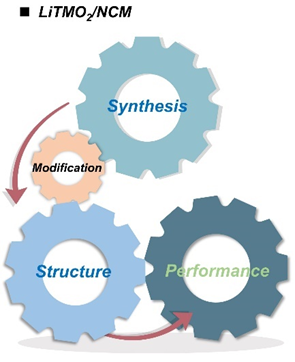

Effect of Synthesis Conditions on The Properties of Cathode Materials for Lithium-Ion Batteries
Received date: 2024-02-05
Revised date: 2024-05-26
Online published: 2024-07-01
Supported by
National Natural Science Foundation of China(22279070)
National Natural Science Foundation of China(U21A20170)
National Natural Science Foundation of China(22279071)
National Natural Science Foundation of China(52206263)
Ministry of Science and Technology of China(2019YFA0705703)
Layered transition metal oxides(LiTMO2)are candidate cathode materials for high-energy-density lithium-ion batteries,primarily owing to their high theoretical specific capacity.Nevertheless,the persistent challenge of chemical-mechanical failure during charge-discharge cycling has impeded its progressive development.In numerous prior investigations,researchers have diligently explored the cycling failure of this material family,presenting a spectrum of modification strategies aimed at addressing this issue including doping,coating,surface or grain boundary modification.Given the impact of lattice defects and heterogeneous structures introduced throughout the synthesis process cannot be overlooked,a comprehensive comprehension of the influence exerted by various controlling factors on the structural formation of materials is imperative.This review aims to elucidate the ramifications of control factors,including precursor,lithium salt,sintering temperature,holding time,and sintering atmosphere,on the material structure during the synthesis process.The objective is to provide the battery community with valuable insights on strategies to synthesize high-performance LiTMO2materials 。
1 Introduction
2 Structural characteristics of high-performance LiTMO2
3 Reduction of inherent defects formed in the synthesis process
3.1 Effect of precursors on the inherent defects in LiTMO2
3.2 Effect of lithium salt species on the structure of LiTMO2
3.3 Effect of sintering regime on the structure of LiTMO2
3.4 Effect of sintering atmosphere and oxygen partial pressure on the structure of LiTMO2
3.5 Water-washing process
4 Conclusion and outlook

Hang Li , Li Wang , Youzhi Song , Zhiguo Zhang , Aimin Du , Xiangming He . Effect of Synthesis Conditions on The Properties of Cathode Materials for Lithium-Ion Batteries[J]. Progress in Chemistry, 2024 , 36(9) : 1304 -1315 . DOI: 10.7536/PC240203
图4 低温老化的升温方式和快速升温方式对材料结构演变影响示意图。低温老化的升温方式可以在促进锂化反应的同时抑制TM(OH)2的分解,而传统的烧结方式会导致表层发生锂化,同时内部发生前驱体分解,进而导致不同尺寸的空洞缺陷[47]Fig. 4 Schematic diagram of the effect of low-temperature aging heating method and fast ramping method on the structural evolution of the material. The low-temperature aging heating method can promote the lithiation reaction while inhibiting the decomposition of TM(OH)2, while the traditional fast ramping method leads to the lithiation of the surface layer while the decomposition of the precursor occurs in the internal layer, which in turn leads to the defects of different sizes of voids[47]. Copyright 2023 Wiley-VCH |
图6 (a)不同Ni含量LiTMO2材料单晶和多晶颗粒烧结温度和气氛;(b)不同温度下LiTMO2一次颗粒尺寸和内部应力变化Fig. 6 (a) Sintering temperature and atmosphere of single and polycrystalline particles of LiTMO2 material with different Ni contents. (b) Variation of primary particle size and internal stress of LiTMO2 at different temperatures |
图7 掺杂1% Mo元素,(a)传统烧结方式,(b)两段烧结方式以及(c)三段烧结方式制备单晶NCM90颗粒升温示意图和晶体形貌[54]Fig. 7 Schematic temperature rise and crystal morphology of single-crystal NCM90 particles prepared by doping 1% Mo element using (a) conventional sintering method, (b) two-section sintering method, and (c) three-section sintering method [54]. Copyright 2023 John Wiley and Sons Ltd |
| [1] |
|
| [2] |
|
| [3] |
|
| [4] |
|
| [5] |
|
| [6] |
|
| [7] |
|
| [8] |
|
| [9] |
|
| [10] |
|
| [11] |
|
| [12] |
|
| [13] |
|
| [14] |
|
| [15] |
|
| [16] |
|
| [17] |
|
| [18] |
|
| [19] |
|
| [20] |
|
| [21] |
|
| [22] |
|
| [23] |
|
| [24] |
|
| [25] |
|
| [26] |
|
| [27] |
|
| [28] |
|
| [29] |
|
| [30] |
|
| [31] |
|
| [32] |
|
| [33] |
|
| [34] |
|
| [35] |
|
| [36] |
|
| [37] |
|
| [38] |
|
| [39] |
|
| [40] |
|
| [41] |
|
| [42] |
|
| [43] |
|
| [44] |
|
| [45] |
|
| [46] |
|
| [47] |
|
| [48] |
|
| [49] |
|
| [50] |
|
| [51] |
|
| [52] |
|
| [53] |
|
| [54] |
|
| [55] |
|
| [56] |
|
| [57] |
|
| [58] |
|
| [59] |
|
| [60] |
|
| [61] |
|
| [62] |
|
| [63] |
|
| [64] |
|
| [65] |
|
| [66] |
|
| [67] |
|
| [68] |
|
/
| 〈 |
|
〉 |